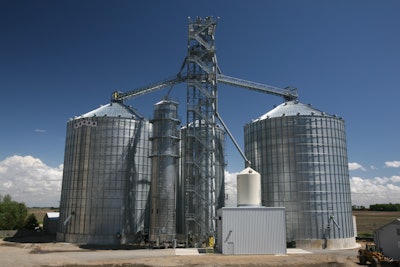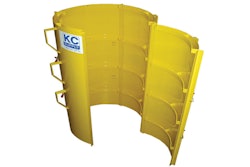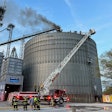
The capacity of grain drying and storage equipment and the amount of grain being handled have increased significantly.
提高粮食干燥和储存已经改变的迹象ificantly as the capacity of equipment used and the amount of grain being handled and stored on farms have increased, according to North Dakota State University Extension Service agricultural engineer Ken Hellevang.
“Safety has become even more crucial in system design and operation because too many people are trapped in grain, get tangled in auger flighting, or develop respiratory problems from exposure to grain dust and mold particles,” he says.
Here is some advice on how to stay safe while working with grain:
Never enter a bin while unloading grain or to break up a grain bridge. Flowing grain will pull a person into the grain mass, burying the individual in a few seconds. A wall of grain can collapse without warning and cover a person.
Never enter a grain bin without stopping the auger and using the “lock-out/tag-out” procedures to secure it. Use a key-type padlock to lock the auger switch in the “off” position to assure that the equipment does not start automatically or someone does not start the equipment accidentally.
Even low-level exposure to dust and mold can cause symptoms such as wheezing, a sore throat, nasal or eye irrigation and congestion. Higher concentrations can cause allergic reactions and trigger asthma episodes and other problems.
Hellevang recommends the minimum protection should be an N-95-rated facemask. This mask has two straps to hold it firmly to the face and a metal strip over the nose to create a tight seal.
Precautions such as these are important to consider when adding or expanding grain handling and storage facilities, he notes.
These and other tips have been added to the latest edition of “Grain Drying, Handling and Storage Handbook,” a publication Hellevang co-authored with extension engineers working with grain facilities from across the country.
“The publication focuses on planning a new grain facility or expanding an existing one,” he says. This handbook was developed to assist farmers, elevator managers, equipment dealers, students, and others interested in developing grain systems.
The “Grain Drying, Handling and Storage Handbook” contains chapters on planning guidelines for drying, handling and storage; locating and developing a grain center; safety and health; automation and control; and basic principles of equipment used for grain drying; handling; and storage.
“The publication is useful to help farmers planning an upgrade in their infrastructure to educate themselves on the various aspects to consider and options before meeting with a design team,” Hellevang adds. “The handbook can assist farmers to obtain a system that efficiently meets their current and future grain drying, handling and storage needs.”
The publication includes tables with information on various types of grain storage facilities. This information is cross-referenced to downloadable spreadsheets. Producers can recalculate the capacities to meet the needs of their grain facilities. In addition, the publication contains numerous figures, illustrations and photos.
To obtain the publication, contact MidWest Plan Service at Iowa State University by email at mwps@iastate.edu or by phone at 515-294-4337, or visit its website athttps://www-mwps.sws.iastate.edu/.





















